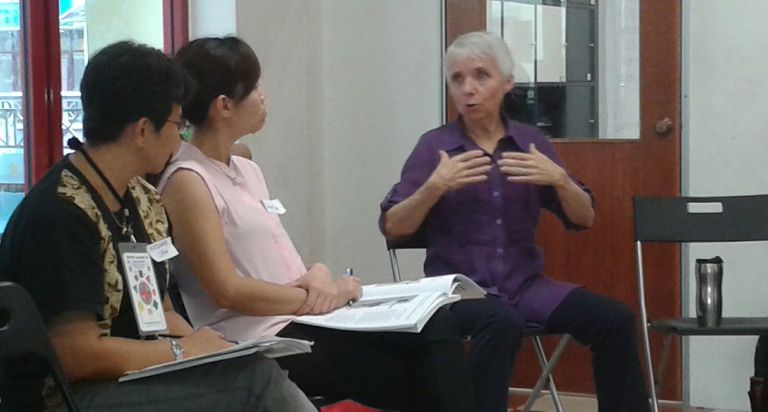In the early years of trying to make sense of what was happening with Nicholas, I subscribed to a gamut of therapies from the mainstream to the alternative, desperate for help and solutions to a frightening situation. And, always looking for a cure despite being told that there was none.
Two decades ago, parents with children having autism were basically alone in the wilderness. In fact the paediatric psychiatrist told me to just accept it and that there is nothing in Malaysia to help such children. Fortunately, the human race was not created to sit back and accept defeat easily.
In the darkness, there is always light.
Back then it was in the form of Parents Resource for Autism (PR4A). I will always be grateful to the few parents who took it upon themselves to set up PR4A. It gave many families a place to start, which was to be the beginning of a long road into a new country called Autism, where we have to learn a new culture and language.
A typical family with a child diagnosed with autism or ASD, would be doing many things — sending the child to an early learning intervention centre, speech therapist, occupational therapist and, even a psychologist.
Additional therapies would include art, music and horse-riding. The more adventurous would also include acupuncture, massage and chelation therapy.
Diet interventions like Gluten Free and Casein Free (GFCF) and Sara’s Diet (essentially a GFCF diet which excludes lutein, a pigment found naturally in fruits and vegetables) would also be on the list of “to dos”. Parents would talk in abbreviated speech like ABA, TEACCH, EIPs, PECs, OTs, SPs and, Son-Rise, among the better known. This list of abbreviated therapies continues to increase as more understanding and research are done on autism.
Besides the information overload, it was also a terribly expensive affair. Therapists were charging by the hour. Consultants were brought in from the US, UK and Australia. Many parents became their children’s therapists and teaching aides. The arena also became competitive as parents traded stories about the different therapies they were doing for their children and the successes.
It was stressful enough to have a child with learning disorders but to have to keep up with the Joneses made the whole situation, quite honestly, depressing for me.
So when Brain Gym for Special Needs and its 26 specific movements walked in with Cecilia Koester, I was bowled over by the difference. A pair of smiling gray eyes looked at me and said, “It is all right and we will work this out together ” instead of the usual, “What I am going to say is very important so you had better listen well and do as I say because my time is precious.”
It was the nicest workshop I had ever attended. In those four days, I learned that, the role of a teacher was to look for the needs of the child and then to help the child overcome the obstacles that are stopping him/her from doing better. Koester (below) was saying things like, “I see you would like to write better, let’s do ….” I was taught to notice and empowered to teach.
In the years to come, I took every opportunity to attend Brain Gym workshops whenever it was available in Malaysia and met instructors who exuded the same gentle intensity and calmness.
Brain Gym is essentially a method that uses goal setting and specific movements to stimulate the brain and help it to organise, focus and/or communicate better. The movements are simple and there are modifications for people who cannot do the movements exactly.
Recently, Koester, a Brain Gym for Special Needs instructor and founder of Movement Based Learning (MBL) was in Kuala Lumpur to teach a workshop on MBL. The workshop explained the importance of specific movement patterns in the neurological development of a child and that movements grow the brain. Milestones in a baby’s life are marked by the movements she made.
As patterns are continuously repeated, the network of brain neurons grow denser and become more secure before the baby moves to another milestone. In fact, research has shown that the brain continues to create new neural pathways and alter existing ones in order to adapt to new experiences, learn new information and create new memories.
So, for a student who cannot get it, is he then stupid? No, his brain is probably wired differently.
Brain Gym helped me to notice things better, the walk, the position of the arms, the movement of the eyes and the tone of the voice, among other things. I have seen physical changes in people who did the movements. For example, a lady whose goal was to be able to bend and touch her toes, did exactly that effortlessly.
I do get the quizzical looks and raised eyebrows when I talk about Brain Gym but that is fine. It is not a cure or anything like that but it supports learning.
More than anything, Brain Gym is very cost-effective, for me. Workshops are very experiential in the delivery so I get to feel first-hand all that I am going to use with Nicholas, almost like “buy 1 free 1”.
Today I am a Brain Gym instructor/consultant and I will always remember my instructors; Sally Kulasegram who kept tabs on me and bullied me into becoming an instructor; Patti Leahy-Shrewsbury, who demonstrated great kindness and patience with a bumbling student. And, of course, my first BrainGym instructor Koester who inspired me.
“Everybody is a genius. But if you judge a fish by its ability to climb a tree, it will live its whole life believing that it is stupid.” – Albert Einstein


